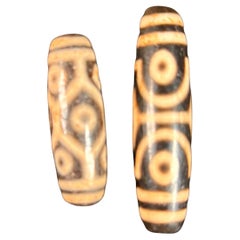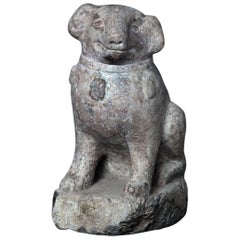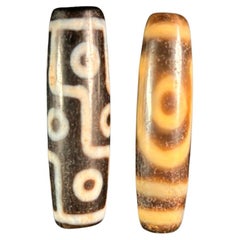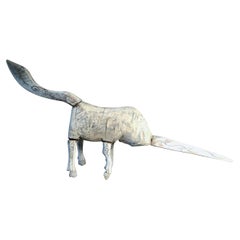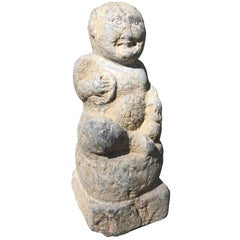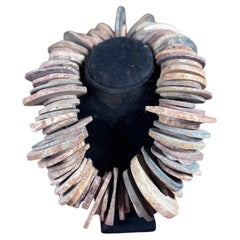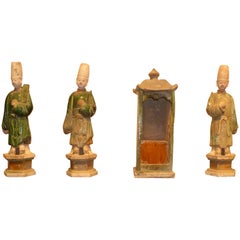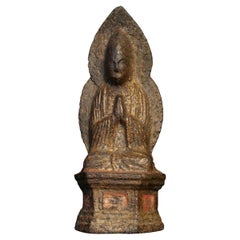Schneible Fine Arts LLC Antiquities
to
9
15
15
12
1
2
11
3
2
2
2
15
14
14
1
1
15
15
15
Tibet Vintage Pair Amulet Pendants Nine And Four Eye Dzi Beads
Located in South Burlington, VT
A unique pair (2), valuable and powerful Protection Amulet Dzi from Tibet
An old Tibetan or Central Asian nine and four eye agates Dzi Beads dating to the ...
Category
20th Century Chinese Qing Antiquities
Materials
Agate
$400 Sale Price / set
20% Off
Important Ancient Chinese Effigy Pug Dog, Ming Dynasty 1368-1644
Located in South Burlington, VT
China, a carving of a canine “Pug”, Ming Dynasty, 1368-1644 CE
Dimensions: 38 cm, 15” High
Photographs taken indoors and out of doors for your viewing pleasure.
The hand carved limestone beast shown on its haunches with naturalistic joyful expression and a well defined compact head, ears, noes, eyes, feet, and tail parted to one side on reverse with distinctive collar ornament seated four square on a thick base all-over showing a weathered surface from significant age.
Formerly exhibited “Asia Week” New York City, Fuller Building, Hutton Gallery 2006.
Provenance: ex collection luoyang, Henan Province, China.
Includes custom display base as shown
Catalog reference: 35 years collecting 35 treasures, Number 35, p.76 (photo)
In ancient China, it is a well-known fact that several types of small dogs were bred and were favored pet gifts between emperors and kings including Lion Dogs, Pekingese and Lo-sze breeds. Some Lo-sze are pictured wearing collars with bells a frequent combination fancied by European royalty of the seventeenth and eighteenth centuries. Lo-sze or pugs were prized for their compact body, good bones, flat face, square jaw, short coat, curled tail, side set back ears, and temperate disposition.
History:
Placing stone animals in important tombs can be traced back at least to the Qin Dynasty (221-206 BCE), some two thousand years ago. In ancient times, stone animals and human figures placed before imperial tombs symbolized royal power and privilege in addition to decorative functions.
The first Ming tomb...
Category
Antique 15th Century and Earlier Chinese Ming Sculptures and Carvings
Materials
Limestone
$6,800 Sale Price
20% Off
Tibet Vintage Pair Amulet Pendants Two And Nine Eye Dzi Beads
Located in South Burlington, VT
A unique pair (2), valuable and powerful Protection Amulet Dzi from Tibet
An old Tibetan or Central Asian two and nine eye agates Dzi Beads dating to the e...
Category
20th Century Chinese Qing Antiquities
Materials
Agate
$400 Sale Price / set
20% Off
Chinese Ancient Hand Carved Unicorn
Located in South Burlington, VT
A Chinese hand carved and hand painted wooden effigy of an extraordinary unicorn dating to the Song dynasty before 1279 AD.
Please enjoy the beautiful remnants of its aged original ...
Category
Antique 15th Century and Earlier Chinese Antiquities
Materials
Wood
China Ancient Stone Entertainer, Han Dynasty 200 AD
Located in South Burlington, VT
China an ancient limestone figure of an Entertainer replete with hands holding tambourines and a top a drum, -for the afterlife- , Han dynasty 206 BC...
Category
Antique 15th Century and Earlier Chinese Han Sculptures and Carvings
Materials
Limestone
$12,000 Sale Price
20% Off
Chinese Cache Ancient Heavenly Green Jade Bi , 94 pieces
Located in South Burlington, VT
This is a guaranteed authentic ancient Chinese jade bi cache of ninety four (94) discs from the Qijia culture, Northwestern China, circa 3000-2000 BCE.
Including Our Certificate of ...
Category
Antique 15th Century and Earlier Chinese Antiquities
Materials
Jade
Chinese Ancient Hongshan Culture Pregnant Female Fertility Sculpture 4700-2900BC
Located in South Burlington, VT
China, a fine archaic conjoined bust sculpture of a male and female hand carved from a granular medium to dark gray stone. Neolithic period, Hongshan culture (circa 4700-2900 BC)
Likely a fertility - progeny sculpture. Please note the pecked surfaces and the stone carved hair line particularly on the back head area.
Quality: Fine original condition, no repairs, as collected. Dark varied patina from appropriate age.
This is likely a unique carving.
Dimensions: 12.25 inches tall and 4.25 inches width.
About Hongshan Culture:
The Hongshan culture was a Neolithic culture in northeastern China. Hongshan sites have been found in an area stretching from Inner Mongolia to Liaoning, and dated from about 4700-2900 BC. The culture is named after Hongshanhou, a site in Hongshan District, Chifeng. The Hongshanhou site was discovered by the Japanese archaeologist Torii Ryuzo in 1908 and extensively excavated in 1935 by Kosaku Hamada and Mizuno Seiichi.
Provenance:
Our private collection and accompanied by our Lifetime Guarantee of Authenticity. Originally collected in the area of Chifeng City, Inner Mongolia.
In addition, our Hongshan stone effigy...
Category
Antique 15th Century and Earlier Chinese Antiquities
Materials
Stone
Ancient China Monumental Stone Ram Han Dynasty, 206BC-220AD
Located in South Burlington, VT
China, a large votive model of a stone ram, Han dynasty (206BC-220AD)
Dimensions: 45cm, 18 inches high and 65cm, 26 inches length and 25cm, 10 inches wi...
Category
Antique 15th Century and Earlier Chinese Han Sculptures and Carvings
Materials
Limestone
$17,600 Sale Price
54% Off
Chinese Ancient Hongshan Culture Stone Sculpture, 4700-2900 BC
Located in South Burlington, VT
China, a fine archaic human effigy hand-carved from a granular medium to dark gray volcanic stone with six (6) "V" sections carved front. Neolithic period, Hongshan culture...
Category
Antique 15th Century and Earlier Chinese Antiquities
Materials
Stone
Chinese Cache Ancient Heavenly Green Jade Bi , 96 pieces
Located in South Burlington, VT
This is a guaranteed authentic ancient Chinese jade bi cache of ninety six (96) discs from the Qijia culture, Northwestern China, circa 3000-2000 BCE.
Including Our Certificate of A...
Category
Antique 15th Century and Earlier Chinese Antiquities
Materials
Jade
Chinese Ancient Hand Carved Wood Lion Guardian
Located in South Burlington, VT
A Chinese hand carved and hand painted wooden effigy of a fantastic Bixie dating to before Song dynasty 1279 AD.
Please enjoy the beautiful remnants of its aged original swirling painted surfaces. It has been traditionally carved and assembled in three sections. The tail may be a later replacement.
Period: Song dynasty
Dimensions: 6 inches high and 15 inches wide
About Bixie
The “bixie” is a mythological creature commonly thought to be able to ward off evil forces with its magical powers. In fact, its name means “to ward off evil” in Chinese. In the Han dynasty, “bixie” were commonly represented as winged, four-legged beasts, a form that was probably transmitted from Western Asia.
Provenance:
This is from a private collection and were acquired by us along with a larger wooden horse...
Category
Antique 15th Century and Earlier Chinese Antiquities
Materials
Wood
$1,440 Sale Price
40% Off
Chinese Stone Fertility Sculpture, 4700-2900 BC
Located in South Burlington, VT
China, a fine archaic male effigy hand carved from a granular medium to dark gray stone. Neolithic period, Hongshan culture (circa 4700-2900 BC)
Likely a fertility fetish. Note the pecked surfaces and the stone carved hair line top knot.
Quality: Fine original condition, no repairs, as collected. Dark varied patina from appropriate age.
Dimensions: 13.5 inches tall and 6 inches width.
About Hongshan Culture:
The Hongshan culture was a Neolithic culture in northeastern China. Hongshan sites have been found in an area stretching from Inner Mongolia to Liaoning, and dated from about 4700-2900 BC. The culture is named after Hongshanhou, a site in Hongshan District, Chifeng. The Hongshanhou site was discovered by the Japanese archaeologist Torii Ryuzo in 1908 and extensively excavated in 1935 by Kosaku Hamada and Mizuno Seiichi.
Provenance:
Our private collection and accompanied by our Lifetime Guarantee of Authenticity. Originally collected in the area of Chifeng City, Inner Mongolia.
In addition, our Hongshan stone effigy...
Category
Antique 15th Century and Earlier Chinese Antiquities
Materials
Stone
Important Chinese Ancient Bronze Money Tree, 25BC-220AD
Located in South Burlington, VT
China, Ancient Bronze “Money Tree” Yaoqian Shu with original pottery base, Han dynasty (25 BCE – 220 CE)
Dimensions: 155cm, 62 inches high
A sculpted terracotta pottery base in the form of a tortoise with attendants and inserted with five individual bronze pole segments with twenty four individual hanging bronze open work money “branches” attached in tiers, four per tier and topped with a figure of a bronze phoenix as apex most bearing varying degrees of malachite and azurite encrustation from ancient burial.
Important Description Details:
Pottery "tortoise" base: 14.5" high and 11" wide
Bronze sections:
7pcs pole bronze sections approximately 8" length each
1pc top "phoenix" bronze section approximately 7" high and 6" wide
20 pcs long bronze hanging wings approximately 10" long and 5" wide each
4 pcs short bronze hanging wings (near top) approximately 7" long and 4" wide each
Total 32 pcs with ancient green and blue azurite patina.
Catalog reference: Schneible Fine arts catalog - 35 Years Collecting Treasures- Number 11p. 28 (see photos)
Provenance: Provenance: Private family collection formerly exhibited “Asia Week” New York City, Fuller Building, Zabriskie Gallery, 2008.
History of money trees:
In the late Han Dynasty tombs...
Category
Antique 15th Century and Earlier Chinese Han Antiquities
Materials
Bronze
$100,000 Sale Price
33% Off
Chinese Ancient Stone Male Figure, 206 BC-220 AD
Located in South Burlington, VT
China, a rare hand carved stone male figure from the Han dynasty (206 BCE-220 CE).
Dimensions: 16 inches tall on its custom stand and and 6 inches wide
Condition: old patina wi...
Category
Antique 15th Century and Earlier Chinese Han Sculptures and Carvings
Materials
Stone
$2,800 Sale Price
27% Off
Miniature Gilt Buddha
Located in South Burlington, VT
Charming sculpture in miniature and with gilding
An antique fun loving handmade and hand caste gilt bronze seated Buddha, 18th-19th century.
These are handcrafted in quality ha...
Category
Antique 19th Century Burmese Sculptures and Carvings
Materials
Bronze
$80 Sale Price
58% Off
Related Items
Set of Refine Ming Dynasty Green Glazed Attendants and a Sedan Chair
Located in Greenwich, CT
A set of very refined green glazed attendants and one sedan chair, each with benevolent facial expression, beautiful colors and lines, Ming dynasty 1368-1644. Three glazed attendants...
Category
Antique 15th Century and Earlier Chinese Ming Sculptures and Carvings
Materials
Pottery
$4,800 / set
H 16 in W 5 in D 4 in
Extremely Early Chinese Buddha, 7359
Located in Ukiah, CA
Extremely early Chinese Buddha. This piece measures a substantial 9 1/4 inches tall and 11 inches with its custom base. Rare and special-it has one of th...
Category
Antique 15th Century and Earlier Chinese Antiquities
Materials
Bronze
Japanese bronze Koro
Located in Beuzevillette, FR
Impressive handmade large and powerfully cast Japanese tripod bronze censer of the 19th century, made during the Meiji period and with mythical animals...
Category
Antique 19th Century Japanese Antiquities
Materials
Brass
China Zhou Dynasty Bronze Perfume Burner
Located in Beuzevillette, FR
Bucket burns perfume in bronze resting on three feet. The body is sculpted with a band frieze with an archaic motif. Two inverted U-shaped handles punctuate the edge. This type of bronze bucket was cast with lost wax from molds in several parts and assembled when the piece was poured, these are the traces that can be seen on the back of the bucket. . The bronze has a beautiful green and dark gray excavation patina. This perfume burner was originally to have longer feet, no doubt arched, cut very long ago since the place of the cut has the same patina as the rest of the piece.
China Zhou Dynasty...
Category
Antique 15th Century and Earlier Chinese Archaistic Antiquities
Materials
Bronze
Ancient 12th Century Khmer Cambodia Sandstone Vishnu Buddha Statue Sculpture 15"
Located in San Diego, CA
An outstanding original ancient Khmer/Cambodian Vishnu buddha carved sandstone head statue/sculpture dating from the 12th century. Mounted on a piece of teak wood base. Marked on the...
Category
Antique 15th Century and Earlier Cambodian Antiquities
Materials
Sandstone
$5,400
H 15 in W 7 in D 6 in
Stunning Terracotta Standing Horse, Tang Dynasty, China '618-907 AD', TL Test
Located in San Pedro Garza Garcia, Nuevo Leon
Magnificent standing horse in orange terracotta and traces of painting. With a finely decorated saddle and with the mane and tail hair braided. TL Test by Ralph Kotalla Lab NE: 09K12...
Category
Antique 15th Century and Earlier Chinese Tang Antiquities
Materials
Terracotta
$21,875
H 18.25 in W 19.66 in D 7 in
Magnificent Court Attendants in Terracotta - Ming Dynasty, China 1368-1644 AD TL
Located in San Pedro Garza Garcia, Nuevo Leon
A magnificent pair of male and female courtiers from the Ming Dynasty (1368-1644 CE) in excellent condition. They are wearing traditional Daopao robes in green and black garments wit...
Category
Antique 15th Century and Earlier Chinese Ming Antiquities
Materials
Terracotta
$21,250
H 25.4 in W 8 in D 5 in
18th Century Hirate Clan Samurai Armor with Signed Kabuto Helmet
Located in Fukuoka, JP
This is a truly exceptional set of 18th century Samurai armor that is sure to impress any collector or enthusiast. The patinated iron used in its construction has aged beautifully, giving the armor a truly unique appearance that is sure to catch the eye. The brocade silk and cotton padding used to line the armor not only provide a comfortable fit for the wearer, but also add an extra layer of decorative flair.
One of the most striking features of this armor is the crests of the Hirate samurai clan that adorn it. These crests are a symbol of the clan's identity and heritage, and their presence on the armor speaks to the deep connection between samurai warriors and the clans they belonged to.
The Kabuto...
Category
Antique 18th Century Japanese Antiquities
Materials
Iron
$24,067
H 18 in W 21.66 in D 19.69 in
Ancient Buddhist Stone Tabletop Altar with a Lotus Flower
Located in Antwerp, BE
An exceptional and very early Buddhist stone altar equipped with two handgrips for moving it to the spot of the planned sacrifice. Carved by hand from a si...
Category
Antique 15th Century and Earlier Asian Hellenistic Antiquities
Materials
Schist
$7,071 Sale Price
20% Off
H 8.67 in W 18.12 in D 2.37 in
Antique Illustration of the Feet of Lord Rama, 'Sri Ram Prada Yatra'
Located in Soquel, CA
Finely detailed illustration of the feet of Lord Rama. The feet are labeled with illustrative symbols, including a lotus flower, shells, and crescent moons. There are a total of 17 s...
Category
Antique 19th Century Indian Other Religious Items
Materials
Gold Leaf
$550
H 0.75 in W 10.75 in D 10 in
An Important Chinese Carved Wood Figure of Guanyin, Ming Dynasty, 17th Century
Located in ARMADALE, VIC
An Important Chinese Carved Wood Figure of Guanyin, Ming Dynasty, 17th Century
Description:
A dignified portrayal of the bodhisattva, respl...
Category
Antique 17th Century Chinese Ming Sculptures and Carvings
Materials
Wood
$29,990
H 43.31 in W 20.48 in D 16.93 in
Northern Wei Dynasty Terracotta Horses, TL Tested, '386 AD-535 AD'
Located in Miami, FL
A massive pottery pair of horses standing on all fours and striding with its right hoof forward. Extended snout ends in parted lips showing teeth beneath in a braying attitude. Low relief bridle on face and well defined eyes. Raised mane down back of the neck
A fantastic example of the Wei dynasty horses.
Large, exquisite walking Ferghana horses with great attention paid to anatomical detail were the choice of the wealthy. The horse was second only in importance to the dragon. It was supposed to possess magical powers which the early Chinese were eager to explore. It would be the horse that would carry the deceased to the next life and it would be the amount of horses that an individual owned that would guarantee his ongoing status in the hereafter.
Thermoluminescence certificate from Madrid Labs included.
In southern China, people turned to Daoism, and mingqi, as well as above-ground sculptures, became ever more infused with animal iconography and energized with dynamic lines.
The north of China was eventually united by nomadic Tuoba invaders who founded the Northern Wei dynasty...
Category
Antique 15th Century and Earlier Chinese Han Antiquities
Materials
Terracotta
$185,000 / set
H 23.42 in W 11.81 in D 20.47 in
